Skinwalkers theme by Paja
Download: Skinwalkers.p3t
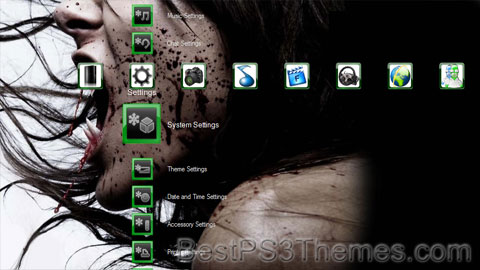
(1 background)
Redirect to:

The #1 spot for Playstation themes!
Essential theme by Paja
Download: Essential.p3t

(1 background)
Essential or essentials may refer to:
Tigers 2008 theme by jpan5447
Download: Tigers2008.p3t
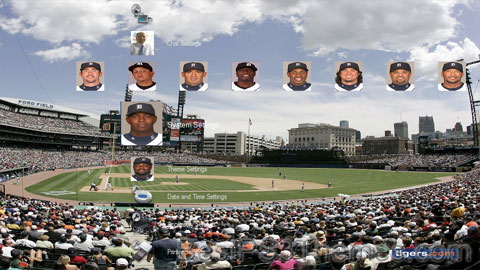
(5 backgrounds)
P3T Unpacker v0.12
Copyright (c) 2007. Anoop Menon
This program unpacks Playstation 3 Theme files (.p3t) so that you can touch-up an existing theme to your likings or use a certain wallpaper from it (as many themes have multiple). But remember, if you use content from another theme and release it, be sure to give credit!
Download for Windows: p3textractor.zip
Instructions:
Download p3textractor.zip from above. Extract the files to a folder with a program such as WinZip or WinRAR. Now there are multiple ways to extract the theme.
The first way is to simply open the p3t file with p3textractor.exe. If you don’t know how to do this, right click the p3t file and select Open With. Alternatively, open the p3t file and it will ask you to select a program to open with. Click Browse and find p3textractor.exe from where you previously extracted it to. It will open CMD and extract the theme to extracted.[filename]. After that, all you need to do for any future p3t files is open them and it will extract.
The second way is very simple. Just drag the p3t file to p3textractor.exe. It will open CMD and extract the theme to extracted.[filename].
For the third way, first put the p3t file you want to extract into the same folder as p3textractor.exe. Open CMD and browse to the folder with p3extractor.exe. Enter the following:
p3textractor filename.p3t [destination path]Replace filename with the name of the p3t file, and replace [destination path] with the name of the folder you want the files to be extracted to. A destination path is not required. By default it will extract to extracted.filename.
Terminal theme by Jeremy Eble
Download: Terminal.p3t

(1 background)
Terminal may refer to:
Extreme Law theme by VolKaniK
Download: ExtremeLaw.p3t
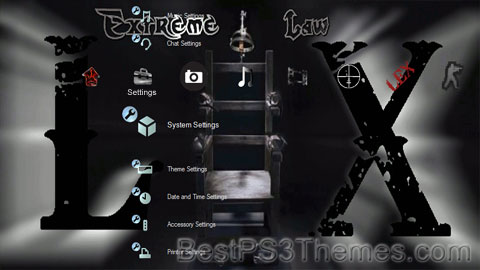
(1 background)
P3T Unpacker v0.12
Copyright (c) 2007. Anoop Menon
This program unpacks Playstation 3 Theme files (.p3t) so that you can touch-up an existing theme to your likings or use a certain wallpaper from it (as many themes have multiple). But remember, if you use content from another theme and release it, be sure to give credit!
Download for Windows: p3textractor.zip
Instructions:
Download p3textractor.zip from above. Extract the files to a folder with a program such as WinZip or WinRAR. Now there are multiple ways to extract the theme.
The first way is to simply open the p3t file with p3textractor.exe. If you don’t know how to do this, right click the p3t file and select Open With. Alternatively, open the p3t file and it will ask you to select a program to open with. Click Browse and find p3textractor.exe from where you previously extracted it to. It will open CMD and extract the theme to extracted.[filename]. After that, all you need to do for any future p3t files is open them and it will extract.
The second way is very simple. Just drag the p3t file to p3textractor.exe. It will open CMD and extract the theme to extracted.[filename].
For the third way, first put the p3t file you want to extract into the same folder as p3textractor.exe. Open CMD and browse to the folder with p3extractor.exe. Enter the following:
p3textractor filename.p3t [destination path]Replace filename with the name of the p3t file, and replace [destination path] with the name of the folder you want the files to be extracted to. A destination path is not required. By default it will extract to extracted.filename.
Girls Of G4 theme by sLaYeR
Download: GirlsofG4.p3t
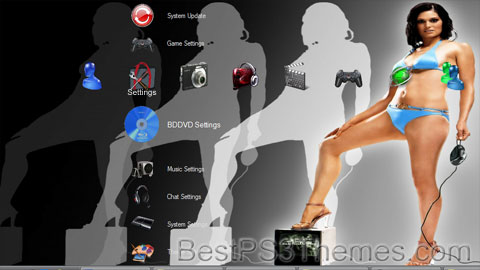
(11 backgrounds)
P3T Unpacker v0.12
Copyright (c) 2007. Anoop Menon
This program unpacks Playstation 3 Theme files (.p3t) so that you can touch-up an existing theme to your likings or use a certain wallpaper from it (as many themes have multiple). But remember, if you use content from another theme and release it, be sure to give credit!
Download for Windows: p3textractor.zip
Instructions:
Download p3textractor.zip from above. Extract the files to a folder with a program such as WinZip or WinRAR. Now there are multiple ways to extract the theme.
The first way is to simply open the p3t file with p3textractor.exe. If you don’t know how to do this, right click the p3t file and select Open With. Alternatively, open the p3t file and it will ask you to select a program to open with. Click Browse and find p3textractor.exe from where you previously extracted it to. It will open CMD and extract the theme to extracted.[filename]. After that, all you need to do for any future p3t files is open them and it will extract.
The second way is very simple. Just drag the p3t file to p3textractor.exe. It will open CMD and extract the theme to extracted.[filename].
For the third way, first put the p3t file you want to extract into the same folder as p3textractor.exe. Open CMD and browse to the folder with p3extractor.exe. Enter the following:
p3textractor filename.p3t [destination path]Replace filename with the name of the p3t file, and replace [destination path] with the name of the folder you want the files to be extracted to. A destination path is not required. By default it will extract to extracted.filename.
Chocolate theme by Tim
Download: Chocolate.p3t

(1 background)
 | |
| Region or state | Mesoamerica |
|---|---|
| Main ingredients | Cocoa bean |
| Variations | Chocolate liquor, cocoa butter, cocoa solids, solid chocolate |
Chocolate, or cocoa, is a food made from roasted and ground cacao seed kernels that is available as a liquid, solid, or paste, either on its own or as a flavoring agent in other foods. Cacao has been consumed in some form for at least 5,300 years starting with the Mayo-Chinchipe culture in what is present-day Ecuador.[1] Later Mesoamerican civilizations also consumed chocolate beverages before being introduced to Europe in the 16th century.[2]
The seeds of the cacao tree have an intense bitter taste and must be fermented to develop the flavor. After fermentation, the seeds are dried, cleaned, and roasted. The shell is removed to produce cocoa nibs, which are then ground to cocoa mass, unadulterated chocolate in rough form. Once the cocoa mass is liquefied by heating, it is called chocolate liquor. The liquor may also be cooled and processed into its two components: cocoa solids and cocoa butter. Baking chocolate, also called bitter chocolate, contains cocoa solids and cocoa butter in varying proportions without any added sugar. Powdered baking cocoa, which contains more fiber than cocoa butter, can be processed with alkali to produce Dutch cocoa. Much of the chocolate consumed today is in the form of sweet chocolate, a combination of cocoa solids, cocoa butter, or added vegetable oils and sugar. Milk chocolate is sweet chocolate that additionally contains milk powder or condensed milk. White chocolate contains cocoa butter, sugar, and milk, but no cocoa solids.
Chocolate is one of the most popular food types and flavors in the world, and many foodstuffs involving chocolate exist, particularly desserts, including cakes, pudding, mousse, chocolate brownies, and chocolate chip cookies. Many candies are filled with or coated with sweetened chocolate. Chocolate bars, either made of solid chocolate or other ingredients coated in chocolate, are eaten as snacks. Gifts of chocolate molded into different shapes (such as eggs, hearts, and coins) are traditional on certain Western holidays, including Christmas, Easter, Valentine's Day, and Hanukkah. Chocolate is also used in cold and hot beverages, such as chocolate milk and hot chocolate, and in some alcoholic drinks, such as creme de cacao.
Although cocoa originated in the Americas, West African countries, particularly Côte d'Ivoire and Ghana, are the leading producers of cocoa in the 21st century, accounting for some 60% of the world cocoa supply.
With some two million children involved in the farming of cocoa in West Africa, child slavery and trafficking associated with the cocoa trade remain major concerns.[3][4] A 2018 report argued that international attempts to improve conditions for children were doomed to failure because of persistent poverty, the absence of schools, increasing world cocoa demand, more intensive farming of cocoa, and continued exploitation of child labor.[3]

Cocoa, pronounced by the Olmecs as kakawa,[5] dates to 1000 BCE or earlier.[5] The word "chocolate" entered the English language from Spanish in about 1600.[6] The word entered Spanish from the word chocolātl in Nahuatl, the language of the Aztecs. The origin of the Nahuatl word is uncertain, as it does not appear in any early Nahuatl source, where the word for chocolate drink is cacahuatl, "cocoa water". It is possible that the Spaniards coined the word (perhaps in order to avoid caca, a vulgar Spanish word for "faeces") by combining the Yucatec Mayan word chocol, "hot", with the Nahuatl word atl, "water".[7] A widely cited proposal is that the derives from unattested xocolatl meaning "bitter drink" is unsupported; the change from x- to ch- is unexplained, as is the -l-. Another proposed etymology derives it from the word chicolatl, meaning "beaten drink", which may derive from the word for the frothing stick, chicoli.[8] Other scholars reject all these proposals, considering the origin of first element of the name to be unknown.[9] The term "chocolatier", for a chocolate confection maker, is attested from 1888.[10]
The cocoa bean was first domesticated at least 5,300 years ago, in equatorial South America from the Santa Ana-La Florida (SALF) site in what is present-day southeast Ecuador (Zamora-Chinchipe Province) by the Mayo-Chinchipe culture, before being introduced in Mesoamerica.[1][11]

Chocolate has been prepared as a drink for nearly all of its history. For example, one vessel found at an Olmec archaeological site on the Gulf Coast of Veracruz, Mexico, dates chocolate's preparation by pre-Olmec peoples as early as 1750 BCE.[12] On the Pacific coast of Chiapas, Mexico, a Mokaya archaeological site provides evidence of cocoa beverages dating even earlier to 1900 BCE.[13][12] The residues and the kind of vessel in which they were found indicate the initial use of cocoa was not simply as a beverage; the white pulp around the cocoa beans was likely used as a source of fermentable sugars for an alcoholic drink.[14]

An early Classic-period (460–480 CE) Maya tomb from the site in Rio Azul had vessels with the Maya glyph for cocoa on them with residue of a chocolate drink, which suggests that the Maya were drinking chocolate around 400 CE.[15] Documents in Maya hieroglyphs stated that chocolate was used for ceremonial purposes in addition to everyday life.[16] The Maya grew cacao trees in their backyards[17] and used the cocoa seeds the trees produced to make a frothy, bitter drink.[18]
By the 15th century, the Aztecs had gained control of a large part of Mesoamerica and had adopted cocoa into their culture. They associated chocolate with Quetzalcoatl, who, according to one legend, was cast away by the other gods for sharing chocolate with humans,[19] and identified its extrication from the pod with the removal of the human heart in sacrifice.[20] In contrast to the Maya, who liked their chocolate warm, the Aztecs drank it cold, seasoning it with a broad variety of additives, including the petals of the Cymbopetalum penduliflorum tree, chili pepper, allspice, vanilla, and honey.
The Aztecs were unable to grow cocoa themselves, as their home in the Mexican highlands was unsuitable for it, so chocolate was a luxury imported into the empire.[19] Those who lived in areas ruled by the Aztecs were required to offer cocoa seeds in payment of the tax they deemed "tribute".[19] Cocoa beans were often used as currency.[21] For example, the Aztecs used a system in which one turkey cost 100 cocoa beans[22] and one fresh avocado was worth three beans.[23]
The Maya and Aztecs associated cocoa with human sacrifice, and chocolate drinks specifically with sacrificial human blood.[24][25] The Spanish royal chronicler Gonzalo Fernández de Oviedo y Valdés described a chocolate drink he had seen in Nicaragua in 1528, mixed with achiote: "because those people are fond of drinking human blood, to make this beverage seem like blood, they add a little achiote, so that it then turns red. ... and part of that foam is left on the lips and around the mouth, and when it is red for having achiote, it seems a horrific thing, because it seems like blood itself."[25]

Until the 16th century, no European had ever heard of the popular drink from the Central American peoples.[19] Christopher Columbus and his son Ferdinand encountered the cocoa bean on Columbus's fourth mission to the Americas on 15 August 1502, when he and his crew stole a large native canoe that proved to contain cocoa beans among other goods for trade.[26] Spanish conquistador Hernán Cortés may have been the first European to encounter it, as the frothy drink was part of the after-dinner routine of Montezuma.[15][27] José de Acosta, a Spanish Jesuit missionary who lived in Peru and then Mexico in the later 16th century, wrote of its growing influence on the Spaniards:
Although bananas are more profitable, cocoa is more highly esteemed in Mexico... Cocoa is a smaller fruit than almonds and thicker, which toasted do not taste bad. It is so prized among the Indians and even among Spaniards... because since it is a dried fruit it can be stored for a long time without deterioration, and they brings ships loaded with them from the province of Guatemala... It also serves as currency, because with five cocoas you can buy one thing, with thirty another, and with a hundred something else, without there being contradiction; and they give these cocoas as alms to the poor who beg for them. The principal product of this cocoa is a concoction which they make that they call "chocolate", which is a crazy thing treasured in that land, and those who are not accustomed are disgusted by it, because it has a foam on top and a bubbling like that of feces, which certainly takes a lot to put up with. Anyway, it is the prized beverage which the Indians offer to nobles who come to or pass through their lands; and the Spaniards, especially Spanish women born in those lands die for black chocolate. This aforementioned chocolate is said to be made in various forms and temperaments, hot, cold, and lukewarm. They are wont to use spices and much chili; they also make it into a paste, and it is said that it is a medicine to treat coughs, the stomach, and colds. Whatever may be the case, in fact those who have not been reared on this opinion are not appetized by it.[28]

While Columbus had taken cocoa beans with him back to Spain,[26] chocolate made no impact until Spanish friars introduced it to the Spanish court.[19] Agustín Farfán, a former court physician and Friar in New Spain, in Tratado Breve de Medicina first introduced cocoa, derived from cacao (native to New Spain), to Europe with a medical use (digestion). Through the 17th and 18th centuries, doctors affirmed the healthy effects of chocolate, consequently boosting the import of chocolate and introducing its consumption in the Europe.[29]
After the Spanish conquest of the Aztecs, chocolate was imported to Europe. There, it quickly became a court favorite. It was still served as a beverage, but the Spanish added sugar, as well as honey (the original sweetener used by the Aztecs for chocolate), to counteract the natural bitterness.[22] Vanilla, another indigenous American introduction, was also a popular additive, with pepper and other spices sometimes used to give the illusion of a more potent vanilla flavor. Unfortunately, these spices tended to unsettle the European constitution; the Encyclopédie states, "The pleasant scent and sublime taste it imparts to chocolate have made it highly recommended; but a long experience having shown that it could potentially upset one's stomach", which is why chocolate without vanilla was sometimes referred to as "healthy chocolate".[30] By 1602, chocolate had made its way from Spain to Austria.[31] By 1662, Pope Alexander VII had declared that religious fasts were not broken by consuming chocolate drinks. Within about a hundred years, chocolate established a foothold throughout Europe.[19]

The new craze for chocolate brought with it a thriving slave market, as between the early 1600s and late 1800s, the laborious and slow processing of the cocoa bean was manual.[19] Cocoa plantations spread, as the English, Dutch, and French colonized and planted. With the depletion of Mesoamerican workers, largely to disease, cocoa production was often the work of poor wage laborers and African slaves. Wind-powered and horse-drawn mills were used to speed production, augmenting human labor. Heating the working areas of the table-mill, an innovation that emerged in France in 1732, also assisted in extraction.[32]
In 1729, the first water-powered machinery to grind cocoa beans was developed by Charles Churchman and his son Walter in Bristol, England.[33] In 1761, Joseph Fry and his partner John Vaughan bought Churchman's premises, founding Fry's.[33] The same year, Fry and Vaughan also acquired their own patent for a water-powered machine that could grind the cocoa beans to a fine powder and thus produce a superior cocoa drink.[34] In 1795, chocolate production entered the Industrial era when Fry's, under the founder's son Joseph Storrs Fry, used a Watt steam engine to ground cocoa beans.[33] The Baker Chocolate Company, which makes Baker's Chocolate, is the oldest producer of chocolate in the United States. Founded by Dr. James Baker and John Hannon in Boston in 1765, the business is still in operation.[35][36]
Despite the drink remaining the traditional form of consumption for a long time, solid chocolate was increasingly consumed since the 18th century.[37][38] Tablets, facilitating the consumption of chocolate under its solid form, have been produced since the early 19th century. Cailler (1819)[39] and Menier (1836)[40] are early examples. In 1830, chocolate is paired with hazelnuts, an innovation due to Kohler.[41]

Meanwhile, new processes that sped the production of chocolate emerged early in the Industrial Revolution. In 1815, Dutch chemist Coenraad van Houten introduced alkaline salts to chocolate, which reduced its bitterness.[19] A few years thereafter, in 1828, he created a press to remove about half the natural fat (cocoa butter) from chocolate liquor, which made chocolate both cheaper to produce and more consistent in quality. This innovation introduced the modern era of chocolate, allowing the mass-production of both pure cocoa butter and cocoa powder.[26]

Known as "Dutch cocoa", this machine-pressed chocolate was instrumental in the transformation of chocolate to its solid form when, in 1847, English chocolatier Joseph Fry discovered a way to make chocolate more easily moldable when he mixed the ingredients of cocoa powder and sugar with melted cocoa butter.[22][33] Subsequently, in 1866 his chocolate factory, Fry's, launched the first mass-produced chocolate bar, Fry's Chocolate Cream, and they became very popular.[42] Milk had sometimes been used as an addition to chocolate beverages since the mid-17th century, but in 1875 Swiss chocolatier Daniel Peter invented milk chocolate by mixing a powdered milk developed by Henri Nestlé with the liquor.[19][26] In 1879, the texture and taste of chocolate was further improved when Rudolphe Lindt invented the conching machine.[43]
Besides Nestlé, several notable chocolate companies had their start in the late 19th and early 20th centuries. Rowntree's of York set up and began producing chocolate in 1862, after buying out the Tuke family business. Cadbury of Birmingham was manufacturing boxed chocolates in England by 1868.[19] Manufacturing their first Easter egg in 1875, Cadbury created the modern chocolate Easter egg after developing a pure cocoa butter that could easily be molded into smooth shapes.[44] In 1893, Milton S. Hershey purchased chocolate processing equipment at the World's Columbian Exposition in Chicago, and soon began the career of Hershey's chocolates with chocolate-coated caramels.

Several types of chocolate can be distinguished. Pure, unsweetened chocolate, often called "baking chocolate", contains primarily cocoa solids and cocoa butter in varying proportions. Much of the chocolate consumed today is in the form of sweet chocolate, which combines chocolate with sugar.
The traditional types of chocolate are dark, milk and white. All of them contain cocoa butter, which is the ingredient defining the physical properties of chocolate (consistency and melting temperature). Plain (or dark) chocolate, as it name suggests, is a form of chocolate that is similar to pure cocoa liquor, although is usually made with a slightly higher proportion of cocoa butter.[45] It is simply defined by its cocoa percentage. In milk chocolate, the non-fat cocoa solids are partly or mostly replaced by milk solids.[46] In white chocolate, they are all replaced by milk solids, hence its ivory color.[47]
Other forms of eating chocolate exist, these include raw chocolate (made with unroasted beans) and ruby chocolate. An additional popular form of eating chocolate, gianduja, is made by incorporating nut paste (typically hazelnut) to the chocolate paste.[48]
Other types of chocolate are used in baking and confectionery. These include baking chocolate (often unsweetened), couverture chocolate (used for coating), compound chocolate (a lower-cost alternative) and modeling chocolate. Modeling chocolate is a chocolate paste made by melting chocolate and combining it with corn syrup, glucose syrup, or golden syrup.[49]

Roughly two-thirds of the entire world's cocoa is produced in West Africa, with 43% sourced from Côte d'Ivoire,[50] where, as of 2007[update], child labor is a common practice to obtain the product.[51][52] According to the World Cocoa Foundation, in 2007 some 50 million people around the world depended on cocoa as a source of livelihood.[53] As of 2007[update] in the UK, most chocolatiers purchase their chocolate from them, to melt, mold and package to their own design.[54] According to the WCF's 2012 report, the Ivory Coast is the largest producer of cocoa in the world.[55] The two main jobs associated with creating chocolate candy are chocolate makers and chocolatiers. Chocolate makers use harvested cocoa beans and other ingredients to produce couverture chocolate (covering). Chocolatiers use the finished couverture to make chocolate candies (bars, truffles, etc.).[56]
Production costs can be decreased by reducing cocoa solids content or by substituting cocoa butter with another fat. Cocoa growers object to allowing the resulting food to be called "chocolate", due to the risk of lower demand for their crops.[53]
The sequencing in 2010 of the genome of the cacao tree may allow yields to be improved.[57] Due to concerns about global warming effects on lowland climate in the narrow band of latitudes where cocoa is grown (20 degrees north and south of the equator), the commercial company Mars, Incorporated and the University of California, Berkeley, are conducting genomic research in 2017–18 to improve the survivability of cacao plants in hot climates.[58]
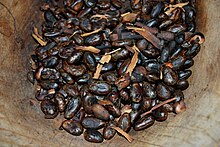
Shadow of the Colossus theme by m0dus
Download: ShadowoftheColossus_3.p3t
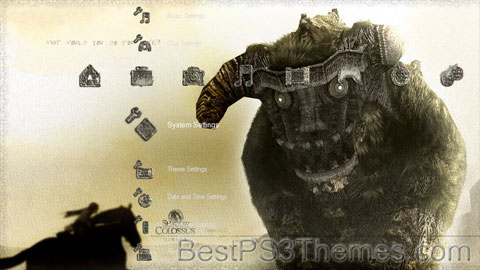
(1 background)
| Shadow of the Colossus | |
|---|---|
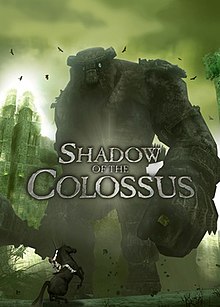 European cover art | |
| Developer(s) | Japan Studio (Team Ico) |
| Publisher(s) | Sony Computer Entertainment |
| Director(s) | Fumito Ueda |
| Producer(s) | Kenji Kaido |
| Writer(s) |
|
| Composer(s) | Kow Otani |
| Platform(s) | PlayStation 2 PlayStation 3 PlayStation 4 |
| Release | |
| Genre(s) | Action-adventure, puzzle |
| Mode(s) | Single-player |
Shadow of the Colossus[a] is a 2005 action-adventure game developed by Japan Studio and Team Ico, and published by Sony Computer Entertainment for the PlayStation 2. It takes place in a fantasy setting and follows Wander, a young man who enters an isolated and abandoned region of the realm seeking the power to revive a girl named Mono. The player assumes the role of Wander as he embarks on a mission that might entail Mono's resurrection: to locate and destroy the colossi, sixteen massive beings spread across the forbidden land, which the protagonist traverses by horseback and on foot.
The game was directed by Fumito Ueda and developed at Sony Computer Entertainment's International Production Studio 1, also known as Team Ico, the same development team responsible for the acclaimed PlayStation 2 title Ico, to which the game is considered a spiritual successor. Сonceived as an online multiplayer game titled NICO directly after Ico's completion, Shadow of the Colossus underwent a lengthy production cycle during which it was redeveloped as a single-player title. The team sought to create an outstanding interactive experience by including a distinct visual design, an unorthodox gameplay template, and non-player characters with sophisticated artificial intelligence such as the colossi and Wander's horse, Agro.
Cited as an influential title in the video game industry and one of the best video games ever made, Shadow of the Colossus is often regarded as an important example of video games as art due to its minimalist landscape designs, immersive gameplay, and emotional weight of the player character's journey. It received wide critical acclaim by the media and was met with strong sales compared to Ico, due in part to a larger marketing campaign. The game won several awards for its audio, design, and overall quality. A remastered version for the PlayStation 3 was released alongside Ico as The Ico & Shadow of the Colossus Collection in September 2011, developed by Bluepoint Games, who later produced a high definition remake of the game for the PlayStation 4 in 2018.
Described by several commentators as an action-adventure game,[2][3] Shadow of the Colossus takes place from a third-person perspective in a three-dimensional (3D) graphic environment and involves combat-based gameplay sequences, as well as platforming and puzzle game elements.[4] The game's environment is largely presented as a seamless open world.[5] Progression through Shadow of the Colossus occurs in cycles. Beginning at a central point in an expansive landscape, the player seeks out and defeats a colossus, and is then returned to the central point to repeat the process.[2] To find each colossus, Wander may raise his sword while in a sunlit area to reflect beams of light, which will converge when the sword is pointed in the right direction of the next encounter.[6] The player's journey to a colossus seldom follows a direct route: stretches of varied terrain often require that a detour be taken along the way. Most colossi are situated in remote areas, such as atop cliffs or within ancient structures.[2][7]
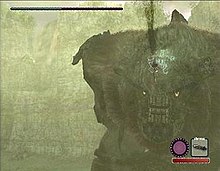
Once a colossus is found, the player must discover its weaknesses to defeat it. Each colossus dwells in a unique lair, and in most encounters the player must use some aspects of the current battlefield to advantage, a necessity that becomes more pronounced as the game progresses.[9] The first two battles take place on simple, vast, flat areas of land, wherein the player's only goal is to discover how to scale the colossi and attack their weak points.[6][9] However, the majority of the following fourteen battles require that the player make use of the surrounding environment.[10][11]
Every colossus has at least one weak point, symbolized by a glowing sigil[12] that can be illuminated and identified by the sword's reflected light.[6][13] Each colossus has areas covered with fur or protruding ledges, which Wander may use to grip and scale the colossus while it thrashes about in an attempt to dislodge him.[2] Wander has a limited stamina gauge that decreases as he hangs onto the colossus; the player thus must act quickly when they scale the creature.[4] Aside from the colossi, who are the only enemies of the game, the environment is inhabited by natural animals. Only one species, however, has an effect on gameplay: eating the tail of a certain kind of lizard increases Wander's stamina gauge. Likewise, the player may find fruit that increases Wander's maximum health.[14]
Wander's horse, Agro,[15] plays a large role in the game. Aside from her capacity as a means of transportation, Agro enables the player to fight from horseback, a critical avenue to defeating some of the colossi.[16] However, the game contains many environments that players cannot traverse by horse, and colossi are often found in areas within deep water or beyond large obstacles that must be scaled. Agro cannot travel beyond these, and when separated from Wander by such obstacles, cannot participate in the following battle.[6] While throughout the game, Wander's equipment consists of only a sword and a bow with arrows,[17] in subsequent playthroughs players may access bonus weapons and in-game features after finishing optional Time Attack trials, which allow the battles with the colossi to be replayed with a restricted time limit.[14]
Presented through a minimalistic narrative,[18] Shadow of the Colossus eschews disclosure of detailed information about the backstories and interrelationships of its characters to the player.[2] The game takes place in a fantasy world,[19][20] wherein a vast and unpopulated peninsula, known as the Forbidden Land, serves as the main setting for the game's events. Separated from the outside realm by a distant mountain range to its north and sea to the south and east, the area contains ruins and remnants of ancient structures, an indication that it had formerly been a settlement.[21][22][23]
The only point of entry to the region is a small cleft in the mountains to the north that leads to a massive stone bridge. This bridge spans half the distance of the landscape and terminates at a large temple called the "Shrine of Worship" located at its center. It is, however, forbidden to enter the land,[24] which includes diverse geographical features, such as lakes, plateaus, canyons, caves, and deserts in addition to human-made structures.[2][11]

The protagonist of the game is Wander (ワンダ, Wanda, voiced by Kenji Nojima), a young man whose goal is to resurrect a girl named Mono (モノ, voiced by Hitomi Nabatame). The only established fact regarding Mono is that she was a maiden who was sacrificed because she was believed to have a cursed destiny.[26] Assisting Wander in his quest to revive her is his loyal horse, Agro (アグロ, Aguro), who serves as his sole ally in defeating the colossi;[27] the English-language version of the game refers to Agro as a male steed,[28] although director Fumito Ueda said that he saw Wander's horse as female.[29] Wander also receives aid from an entity called Dormin (ドルミン, Dorumin, voiced by Kazuhiro Nakata and Kyōko Hikami). The story revolves around these characters but features a small supporting cast, represented by Lord Emon (エモン, voiced by Naoki Bandō) and his men.
Speaking with two voices at once (one male and one female), Dormin is a mysterious, disembodied entity. According to legends of the game's world, Dormin has the power to revive the dead;[24][27] this premise serves as the driving cause for Wander's entrance upon the forbidden land, as he seeks the being's assistance in reviving Mono. Dormin offers to revive her in exchange for Wander destroying the sixteen colossi.[26] One of the commentators of the game's plot speculated that the name "Dormin", which spells "Nimrod" backwards, serves as a reference to the body of the biblical King Nimrod which was cut up and scattered.[30]
Lord Emon is a shaman who narrates a vision in the game's introduction that vaguely explains the origin of the land to which Wander has come and establishes that entry to this place is forbidden.[24] As portrayed by the game, he possesses vast knowledge about the nature and containment of Dormin, and wields the ability to use powerful magic. He has a small group of warriors at his command, and is pursuing Wander to prevent the use of "the forbidden spell", the rite that involves the destruction of the sixteen colossi and the restoration of Dormin's power.[31]
The colossi are armored, most often enormous creatures with forms ranging from various humanoids to predatory animals, and live in all manner of surroundings and environments, including underwater and flying through the air.[18][32] Their bodies are a fusion of organic and inorganic parts such as rock, earth, and architectural elements,[4] some of which are weathered or fractured. Some colossi are peaceful and will only attack when provoked, whereas others are aggressive and will attack on sight.[2] Inhabiting specific locations in the forbidden land, they do not venture outside their own territory. Once slain they will remain where fallen, as a mound of earth and rock vaguely resembling the original colossus.[33][34] A pillar of light marks the location of each colossus after they are defeated.[35] The Latin names of the colossi, though spread throughout fan related media, are not official and are never referred to within the game.[36][37]
As the game begins, Wander enters the forbidden land and travels across a long bridge on his horse, Agro. After they reach the entrance to the Shrine of Worship, Wander, who has carried with him the body of Mono, brings her to an altar in the temple. A moment later, several humanoid shadow creatures appear and approach Wander before he easily dismisses them with a wave of the ancient sword in his possession.
After the shadow creatures are vanquished, the disembodied voice of Dormin manifests within the shrine and expresses surprise at the fact that Wander possesses the weapon. Wander explains the plight that led him to seek the forbidden land and asks that Dormin return Mono's soul to her body. Dormin offers to grant Wander's request under the condition that he completes a rite designed to destroy the sixteen idols lining the temple's hall. To that end, Wander must use his sword to slay each of the idol's physical incarnations–the colossi, whose presence ranges across the vast expanse outside the temple. Although warned by Dormin that he may have to pay a great price to revive Mono, Wander sets out to search the land for the colossi and destroy them.[38]
An aspect of Wander's mission that is unknown to him is that the colossi contain portions of Dormin's own essence, scattered long ago to render the entity powerless.[26][39] As Wander kills each colossus, a released fragment of Dormin enters his body. Over time, the signs of Wander's deterioration from the gathered essence start to appear: his skin becomes paler, his hair darker, and his face is increasingly covered by dark veins. The outcome of the battle with the twelfth colossus leads to a reveal of a group of warriors that has been pursuing Wander, led by Emon. Urged to hurry with his task by Dormin, Wander soon heads off to defeat the sixteenth and final colossus. On the way to this confrontation, he rides horseback across a long bridge which begins to collapse as he is halfway across, but Agro manages to throw Wander over to the other side before falling into the distant river below.
Soon after, Wander goes on to defeat the final colossus as Emon's company arrives in the Shrine of Worship to witness the last temple idol crumble. Wander appears back in the temple soon after, the signs of his corruption readily apparent: his skin is pallid, his eyes glow silver, and a pair of tiny horns have sprouted from his head. Emon recognizes him as a transgressor who, in an event that occurred before Wander's journey to the forbidden land, stole the ancient sword with which he killed the colossi.[31] Emon orders his warriors to kill the "possessed" man as he approaches Mono and finally falls once stabbed through the heart by one of Emon's men.[40] However, a newly whole Dormin takes control of Wander's body and transforms into a shadowy giant.[39][41] While his men flee, Lord Emon casts the ancient sword into a small pool at the back of the temple's hall to evoke a whirlwind of light. The supernatural vortex consumes Dormin and Wander, which seals Dormin within the temple once again. As Emon and his warriors escape, the bridge that leads to the temple collapses behind them, and its destruction forever isolates the forbidden land from the rest of the world. Although he has condemned Wander for his actions prior to their encounter, Emon expresses hope that Wander may be able to atone for his crimes one day should he have survived.[42]
Back in the temple, Mono awakens and finds Agro limping into the temple with an injured hind leg. Mono follows Agro to the pool into which Wander and Dormin were pulled by Emon's spell, where she finds a male infant with tiny horns on his head. Mono takes the child with her, following the horse to higher levels of the Shrine of Worship, and arrives at a secret garden within the shrine as the game ends.

Shadow of the Colossus is the second project of Team Ico, a group of staff members within Sony Computer Entertainment's (SCEI) International Production Studio 1 that was led by director Fumito Ueda and producer Kenji Kaido.[32][43][44] The game originated from one of Ueda's concepts that he developed directly after the team submitted their debut title Ico, released in late 2001 for Sony's PlayStation 2 video game console, for publication.[45][46][47] As the basis of Team Ico's subsequent game had not been decided, Ueda examined "a number of old ideas kicking around in my head ... that couldn't be realized under previous circumstances".[48] After a brief review of those avenues, Ueda chose to explore one that aligned with his own preferences as a game player.[47][48] Ueda cited The Legend of Zelda series as an influence, as he grew up wanting to make a game like Zelda and designed the Colossi bosses like "inverted Zelda dungeons."[49][50]
Ueda envisioned a work with an underlying motif of "cruelty as a means of expression".[48] He felt that this theme was widely featured in contemporary titles such as Grand Theft Auto III and wanted to use it in a game that he designed.[48] In a discussion with Kaido, Ueda observed that he had played a variety of video games containing battles with large bosses that the player must shoot from a distance to defeat.[51] Ueda believed that the boss sequences of those games could be streamlined if the player character was able to approach and climb the oversized opponents to kill them with a close range weapon.[51] Accordingly, he chose to base the game around the player character's encounters with enormous fictional creatures,[16] a premise that stemmed from Ueda's childhood fascination with monster movies.[46] This led to an emphasis on the inclusion of a large-scale adventure in the title, an element which Ueda regarded as influential in the shaping of the game's stylistic identity.[48]
Originally, the team considered Ueda's idea alongside another concurrently-developed game.[45][46] According to Ueda, the game was unrelated to his former concept, and the team did not give it a working title or outline its design while it was in development.[45][46] Ueda recognized the finished iteration of Team Ico's second title as, "in many ways, a game for boys and men"; conversely, the separately produced game was fashioned to appeal more to a female audience.[46] Its contents, interface and thematic focus differed significantly from those that would ultimately manifest in the team's next game after Ico.[46] The untitled game did not employ 3D graphics, whereas Team Ico applied them to their published game.[46] The team eventually scrapped their plans for a counterpart title to Ueda's intended game,[46] which was advanced into further development.[45]
Prior to the start of the project, Team Ico assessed the opportunity to establish it as a sequel to their first game.[16] This suggestion was opposed by certain staff members who argued that the story and gameplay of their preceding title were largely self-contained, and that the existence of consumer demand for a new Ico game was questionable.[52] According to Ueda, Team Ico assumed that the creation of levels for a single-player game akin to Ico necessitated the construction of elaborate puzzles, a practice that the staff wanted to eschew.[51] Following lengthy deliberations, they decided not to pursue a sequel to Ico and to produce a standalone game provisionally dubbed NICO (a portmanteau of ni, 2 in Japanese, and "Ico").[16][32] The team initially agreed to develop NICO as an online multiplayer game that, unlike Ico, "wouldn't require complex level design".[51] Their foundational goal, according to Kaido, was to create a technology demo that represented a tentative rendition of the game's fictional world and features.[16] Development commenced immediately after the December 2001 release of Ico's Japanese version.[16][53]

To develop the concept video for NICO, Team Ico formed a small internal group, which was composed of Ueda, one of Ico's designers and a roughly 10-person animation team.[48] Their objective was to deliver "[a] movie with an extremely final form" that could serve as a visual template for the finalized game.[16] The first storyboard that outlined the video was drafted in January 2002, and the actual short film was completed that May.[54] It depicted a group of three masked, horned boys who rode horseback across a vast landscape and attacked a towering being reminiscent of the second boss in Shadow of the Colossus.[35][55][56] The video was visualized in the Ico game engine and was rendered in real-time on the PlayStation 2 hardware.[16] With those techniques, the team aimed to estimate the extent to which the platform's capabilities allowed the realization of their vision.[16]
According to Kaido, the team deemed the resulting video to have attained a very high level of completion, and thus was able to use it as a reference point throughout the game's production.[16] Although they subsequently modified the game's visuals from those of the demonstration reel, its themes of "fighting a giant enemy" and "[exploring] a giant field" carried over into the final game design.[16] The demo indicated elements that were excluded from the released game.[57] Among these was a showcased gameplay mechanism wherein one of the colossus' attackers who had scaled and killed it proceeded to mount his approaching horse by leaping onto its back from the entity's corpse.[57] The video was later exhibited at many trade shows,[43] such as the 2006 D.I.C.E. Summit in Las Vegas where Kaido and Ueda retrospectively discussed the game's development with Lorne Lanning.[55]
In June 2002, a small group of staff at Team Ico started to build a prototype of NICO for testing purposes.[54] In his role as producer, Kaido tasked the team with the inclusion of technological features that he recognized as important milestones of the development.[55] One of the challenges issued by Kaido involved the creation of "organic collision deformation", a term that alluded to his concept of realistic character physics in relation to the movement of the colossi.[55] For instance, if a colossus' limb was currently horizontal, Kaido expected the player to be able to run across the limb as though it were any other flat surface.[55] Ueda and Team Ico programmers spent over six months to produce a working version of this functionality.[54] They began by adding a character to a virtual environment where the figure was enabled to climb a pole-like object.[51] One of the team's priorities at the time was to code a physics-based simulation of scenarios where characters were "being shaken off or narrowly avoided being stomped on".[58]
In May 2003, Team Ico assembled a demonstrational build of NICO and presented it at a production meeting.[54] Full development of the game was sanctioned directly after it was pitched, and commenced in the same month.[54] That year, the NICO technology demo was shown across Sony's foreign offices among a lineup of prospective PlayStation 2 titles, and its exposure excited the spectators.[57] Although the team attempted to work on the game in secrecy, at a certain point images of NICO's horseriding characters were leaked onto the Internet.[32] Their circulation led enthusiasts to speculate about what they perceived as a sequel to Ico.[32] According to Ueda, the team reused elements of Ico's character designs for NICO to expedite the production of the concept video and minimize its costs.[58] He asserted that NICO was not related to Ico despite their stylistic similarities,[58] and that his colleagues did not identify the former game as a sequel.[4] However, contemporary and retrospective sources described Team Ico's second game as both a spiritual successor[32][47][59] and prequel to Ico.[60]
The staff used player feedback to advance the testing of the "organic collision deformation" system by inputting simple objects to experiment its capabilities.[58] Although Team Ico had conducted an elaborate research of the game's technological framework, they did not finish its validation when they entered the production phase.[51] After evaluating the limited number of personnel that was involved with NICO as well as their professional profiles, Team Ico concluded that they were not qualified to deliver an online-only game.[51] They then resolved to abandon that direction and to reformulate NICO into a single-player title.[51] The team discarded Ico's development tools that they had used at the outset of the project and moved to write new programming utilities.
Borderlands theme by Ramman Download: Borderlands_2.p3t Redirect to: Dead Space theme by Ramman Download: DeadSpace.p3t Dead Space is a science fiction/horror franchise created and directed by Glen Schofield. Dead Space was developed by Visceral Games and published and owned by Electronic Arts. The franchise's chronology is not presented in a linear format; each installment in the Dead Space franchise is a continuation or addition to a continuing storyline, with sections of the storyline presented in prequels or sequels, sometimes presented in other media from the originating video game series, which includes two films and several comic books and novels.
Primarily set in a 26th century science fiction universe featuring environments, weapons, and characters typical of the genre, the Dead Space franchise centers on a series of video games beginning with the release of the first Dead Space, which centers on starship engineer Isaac Clarke and mutated undead horrors that surround him. A central theme in the games is the fictional cult religion "Unitology" and its fanatical adherents, who believe that information about an alien artifact called the "Marker" is being suppressed by "EarthGov", the central political administration of Earth. Their primary goal is to use the Marker as a means to bring about the "Convergence", or complete destruction of humanity, with the Marker and its malevolent influence being the source of the undead monsters encountered by the series' protagonists.
The Dead Space video game series has been positively received; the first game in particular won a number of industry awards for the varied elements of its gameplay and development, and is often regarded as one of the best video games of all time by critics. From a commercial perspective, EA considered the video game series as a whole to have underperformed. After the financial disappointment of 2013's Dead Space 3, no further media for the franchise was produced until a remake of the first game was developed by Motive Studio and released on January 27, 2023.
Systems engineer Isaac Clarke joins a search and rescue team for the USG Ishimura, which had gone radio-silent, after receiving a message from his girlfriend Nicole. Their ship suffers damage when attempting to dock with the Ishimura; while the rest of the crew assess the situation and search for a means to leave the Ishimura, Isaac explores the ship to look for Nicole. The ship is overrun by Necromorphs, forcing Isaac to defend himself by weaponizing his mining tools and "Resource Integration Gear" (RIG) spacesuit capabilities. Due to the Red Marker's influence, Isaac experiences recurring visions of Nicole, who guides him to return the Marker to the planet. Towards the end of the game, it is revealed that one of the rescue team members, Kendra Daniels, is a double agent. She betrays Isaac, but is killed by a large Necromorph creature before she can escape, while Isaac commandeers her ship and escapes Aegis VII after defeating the creature and allowing the Marker to be destroyed by a sabotage attempt he had initiated earlier. The sole survivor of the entire ordeal, Isaac soon hears something behind him and looks back to see a horrific hallucination of Nicole.
Dead Space 2 reveals that Isaac has become mentally disturbed and unstable after he destroyed the Red Marker on Aegis VII, and that he was captured by EarthGov and taken to the Sprawl, a massive space-station built into the remains of Titan, Saturn's largest moon. Once there, EarthGov scientists extract information from his mind to build another Marker, and he is later confined to a hospital on the Sprawl due to a dementia-like mental illness caused by the first Marker. A Necromorph outbreak in the Sprawl instigated by the Marker copy soon occurs, thrusting Isaac into a struggle to survive the Necromorph epidemic. Haunted by hallucinations of the deceased Nicole Brennan, Isaac manages to destroy the Marker copy and undo its influence on his mind. Isaac succeeds in escaping with another survivor, Ellie Langford, before the explosive destruction of the station, and goes into hiding from EarthGov authorities as his mind still retains information about the Markers.
Dead Space 3 occurs a few years later. While Isaac Clarke and Ellie Langford returned to Earth and dated for a while, their relationship fell apart. As he is struggling with the breakup in his apartment on the moon, Unitologists led by Jacob Danik activate a Marker near the colony, causing a Necromorph outbreak. Isaac is rescued and enlisted by EarthGov soldiers to help locate Langford, who had traveled to Tau Volantis, one of Earth's oldest off-world colonies, in search of the true origins of the Markers and a means to stop the Necromorph scourge once and for all.
Rumors of a revival of Dead Space within EA appeared in early 2021. Venture Beat reported in July that this revival was a remake of the first game, in the same vein as the Resident Evil 2 remake, and would be a relaunch of the franchise. EA confirmed the remake of Dead Space, under development by Motive Studio, in their EA Play event the same month.[8][9] It was released on January 27, 2023.
A prequel to the first Dead Space, Dead Space: Extraction follows a group of colonists from the Aegis VII colony who are beset by Necromorphs created when the Red Marker is removed. Originally released as a rail shooter title for the Nintendo Wii in 2009, a port with PlayStation Move support for the PlayStation 3 was later released as a downloadable game on the PlayStation Network in 2011. It was also bundled with copies of the limited editions of Dead Space 2 for the PlayStation 3.
A prequel to Dead Space 2 released in 2010, Dead Space Ignition is an action puzzle video game which follows Franco Delille, an engineer who witnesses the initial Necromorph outbreak on the Sprawl. The ending of Ignition directly sets up the opening of Dead Space 2, where Delille is ordered to find and free Isaac Clarke from an EarthGov asylum, only to be killed and transformed into a Necromorph.
A 2011 tie-in to Dead Space 2 developed by IronMonkey Studios, Dead Space was a mobile title about a newly converted Unitologist on a mission in the mines of Titan Station. The game features an appearance from Titan Station's director Hans Tiedemann, a major antagonist of Dead Space 2, and provides context behind the Necromorph infestation of the Sprawl. It has since been removed from all mobile app storefronts.[10]
The Dead Space franchise is set in the future, where humanity has been able to colonize other planets.[11] By the 23rd century, humanity has used up most of Earth's natural resources, and the world governing body, EarthGov, has fleets of "planet crackers", giant mining spaceships that harvest resources by breaking apart other planets, to gather materials for humanity to sustain itself.[11] During the 23rd century, EarthGov researchers find a double helix-shaped alien artifact in the Chicxulub crater, which they call the Marker. The Marker emits a persistent electromagnetic field from seemingly no source, which researchers believe could be used to provide limitless energy and solve Earth's ecological crisis. Work begins to reverse engineer the Marker on various research stations across the colonies, but they are forced to use bismuth instead of an unidentified alien material, resulting in these duplicates being colored red instead of black as the original.
The project was highly classified, but the lead researcher Michael Altman leaks its existence to the world.[11] EarthGov assassinates Altman hoping to quell the news, but it is too late: Altman is seen as a martyr, and his belief of what the Marker means for humanity form the basis of a new cult-like religion, Unitology, that rapidly spreads across Earth and the colonies.[11] Unitologists believe that by worshipping the Marker, they will discover the true origin and meaning of human life.[11] They also believe that the Marker grants eternal life and will help to unify humanity, as to "make us whole", in an event known as the "Convergence".
The EarthGov researchers also discover that the electromagnetic fields sent by the Marker and its duplicates cause living people to suffer paranoia and hallucinations, while also causing the dead to reanimate, becoming "Necromorphs", biological monstrosities which rise to attack the living. EarthGov immediately terminates the Marker project and abandons all research stations where the work had been done, covering up their locations, knowing as they do that the followers of Unitology would desperately want to seek these Markers out in order to advance their beliefs and bring about Convergence.
In the 26th century, a planet-cracker vessel mining the world of Aegis VII called the USG Ishimura discovers a Red Marker buried near an abandoned colony.[11] The Ishimura captain, a devout Unitologist, ordered his crew to bring the Marker aboard the ship, which causes the crew to become paranoid, turn on each other, and leads to a Necromorph infestation onboard the Ishimura.[11] Among the crew of the Ishimura is a medical officer named Nicole Brennan, who sends a cryptic distress signal to her significant other out of desperation.
The Dead Space games franchise follow the survival horror genre, with the player character visible at all times. All menu interfaces are diegetic, produced by the character's "Resource Integration Gear" spacesuit for ease of communication with other characters. For instance, the character's hit point meter, built into the spine of his suit, is intended to allow co-workers to monitor his health, and when the character moves into depressurized areas, a readout on his back displays his remaining seconds of oxygen. All sound is removed from gameplay during these segments, save those which would be transferred to the character's ears by the vibrations of his RIG, such as rounds fired from his weapon. Since the menus are diegetic, opening them does not pause gameplay.
The character's RIG can be outfitted with two special abilities for use in combat and puzzle-solving. The "Kinesis" module allows the character to retrieve, levitate and transport objects, often heavier or more distant ones than could be accessed normally. These objects may also be expelled at high speed for use as improvised projectiles. The "Stasis" module causes its target to undergo an extreme slowdown for a short period of time, allowing characters to dart through rapidly moving obstacles such as fan blades, or hinder onrushing enemies. The RIG also has a slot-based inventory for carrying weapons, ammunition, healing items, and other objects.
Gunplay is influenced by the franchise's antagonists. Because Necromorphs are re-animated and re-purposed corpses, lacking dependence on nervous, respiratory, and circulatory systems, the conventions of stopping power are largely irrelevant to them. Thus, instead of targeting foes' heads or center of mass, players are encouraged to engage in "strategic dismemberment" by shooting off their arms and legs. Some Necromorphs can be easily defeated in this manner, but others may change attack patterns or even spawn entirely new enemies when slain. Relatedly, the game's weapons are characterized as being repurposed power tools[12] or mining implements, such as plasma cutters, rotary saws, and gravitic repulsion tools, though an increasing amount of dedicated military ordnance becomes available as the franchise progresses. Ammunition tends to be uncommon, thus necessitating careful usage of the tools at hand.
In the first two games, RIGs and weapons can be upgraded at bench workstations. Players can also visit vending machines to buy or sell items for in-game currency, and upload new schematics to those stores in order to unlock new items. This was changed in the third installment, where the store was scrapped entirely; new "Suit Kiosks" allow the player to upgrade their RIG, and bench functionality was expanded to allow players to craft their own weapons, often by cobbling together parts and resources scavenged through gameplay.
Each type of Necromorph has a unique way of slaying the player character, customized to whatever claws, blades, fangs, or probosces they happen to possess.
Electronic Arts (EA) Redwood Shores had developed a number of movie and tie-in games, though they desired to make their own intellectual property. Around 2005, the studio presented the idea of making a second sequel to System Shock to EA executives but had not gotten much support until the release of Resident Evil 4 in 2005, which quickly became a top-selling title. That success led them to revise their System Shock concept, making it more a horror-driven game set in space, and which EA was more open to as to try to capture a similar type of success. The aim was to create, in Glen Schofield's words, "the most terrifying game we could acquire". The subsequent game became Dead Space, released in 2008.[13] Dead Space did well, leading EA to rebrand Redwood Shores as Visceral Games in 2009 and operate as a "genre" studio.[14]
During the development for Dead Space, EA Redwood Shores (now Visceral Games) gave Isaac a portmanteau name from the science fiction writers Isaac Asimov and Arthur C. Clarke.[15] During development for Dead Space 2, Visceral Games decided to give Isaac a voice and chose Gunner Wright.[16][17][18][19][20] As Wright's performance was motion captured, this influenced Clarke's appearance and movement in the game.[21]
The concept behind the fictional religion of Unitology, which has its own scripture of some kind, is supposed to represent people's illogical thinking about things they don't understand, such as the Marker and the Necromorphs. While it is not meant as a criticism of religion itself, it draws on the falsehoods and corruption that may be hidden inside one.[22] In response to comparisons which have been made by commentators between the fictional Unitology and the real-world Scientology, the developers have stated that they simply meant to portray Unitology as a secretive cult, with the name similarity causing unfortunate implications.[23][24]
While Visceral tried to recreate a similar experience with Dante's Inferno, the title did not perform as well, and EA instead had Visceral return to make the sequel Dead Space 2, released in 2011.[25] While it was critically well-received, the title was said to have not performed well financially due to a large development budget.[26][25] EA had Visceral continue to make Dead Space 3, but asked the studio to make key changes to draw more people to the title, such as adding co-op and introducing gameplay elements to help make the title faster, an aspect in direct conflict with the slow pacing of survival-horror games.
Visceral had planned out ideas for a fourth Dead Space game, but at that point, EA transitioned the studio to work on other existing projects, shelving the series after the developer's closure in October 2017.[25] According to former creative director Ben Wanat, their idea of Dead Space 4 was based on concepts from the flotilla section in Dead Space 3, where the player would need to go between the remnants of dead starships to collect parts needed to allow their own craft to survive and gain faster-than-light travel abilities in order to get to a new system. The game would have been a hybrid between non-linear and linear storytelling: while the order of star systems the player visited would have been set by the game, how they proceeded within each system would have been more open. They had considered switching from Isaac to Ellie Langford as the protagonist for the proposed sequel.[27]
In July 2021, EA announced that a remake of the first game with its proprietary Frostbite Engine was under development by Motive Studio.[9]
Jason Graves was the main composer of the music for all mainline entries in the series and the majority of spin-off titles. Other composers have been involved in the series; Grave's recurring collaborator Rod Abernethy acted as an early advisor for the titular first game, James Hannigan co-composed the score for Dead Space 3, while Seth Podowitz and Christopher Tin were the respective composers for the movies Dead Space: Downfall and Dead Space: Aftermath.
Isaac Clarke is the lead character of the Dead Space main series video games. Originally a ship system engineer, his life changes for the worse when a seemingly-routine repair mission becomes a struggle to survive the Necromorph scourge. He originally volunteered the mission to make contact with his girlfriend, who is stationed on the USG Ishimura. Clarke is a silent protagonist in the first game, and is voiced by Gunner Wright in the sequels and the first game's remake.[12]
Nicole is a medical officer aboard the USG Ishimura and Isaac's girlfriend. She appears at Isaac's side at times of struggle, but later logs reveal that she committed suicide long before Isaac arrived; her appearances have actually been hallucinations created by the Markers with the intent of manipulating Isaac into furthering their agenda. She appears in a similar guise over the course of the second game, serving as a sympathetic antagonist. She is voiced by Iyari Limon in the first game and Tanya Clarke in the second.
Nolan Stross appears in Dead Space 2 and is one of the protagonists in the animated feature Dead Space: Aftermath. Stross was once a high-ranking scientist but suffered from dementia after coming into contact with the Red Marker, and was placed in a psychiatric ward of a hospital on Titan Station. While he and Isaac Clarke attempt to band together to destroy the Marker causing the events of the second game, his madness gets the better of him, and Isaac is forced to kill him. He is voiced by Curt Cornelius. Like Isaac Clarke, the character is named after two science fiction authors, in this case, William F. Nolan and Charles Stross.
Ellie is a major non-player character in Dead Space 2 and Dead Space 3. In the first sequel, she and Isaac work together to escape the Titan Sprawl, and between the two games, they begin a romance. However, by the time of the second sequel, they have separated, partially because Isaac is hesitant to wager his life stopping the Markers. Ellie, with the help of Earth Defense Force Captain Robert Norton, discovers evidence that the planet Tau Volantis is the Marker homeworld; she sends Norton to recruit Isaac, kicking off the events of the third game. She is voiced by and modeled after actress Sonita Henry.[28]
Sgt. John Carver is a character in Dead Space 3, and the protagonist of the tie-in graphic novel Dead Space: Liberation. The graphic novel depicts his past as a loyal EarthGov soldier with troubled home life. Damara and Dylan, his wife and son, are killed by Dead Space 3 antagonist Jacob Danik, and Carver joins forces with Ellie Langford to prevent Danik from triggering Convergence. He is voiced by and modeled after Ricardo Chavira.
Under normal circumstances, Carver is a non-player character, dispensing advice and guidance to Isaac but not assisting in gameplay. However, Dead Space 3 features "drop-in drop-out" co-operative multiplayer: the game's single-player campaign can at any time become a co-operative experience if a second player joins via Xbox Live or other networking services. If a second player does join, Carver is that player's in-game character; as such, he is seamlessly written in and out of the campaign at any time to facilitate the presence (or absence) of said other player. Additionally, if a second player is present, side missions become available that deal with Carver's guilt concerning the way he treated his family, as well as over their deaths.
The Dead Space franchise includes various types of adaptations and merchandise outside of the video games. EA's multimedia efforts to market the franchise includes novels, comic books, animated films, and other licensed products like action figures of series protagonist Isaac Clarke.[29][30][31]
The Dead Space franchise has been adapted into literary format, beginning with a comic book miniseries which serve as a prequel to both the first Dead Space game and the Dead Space: Downfall film. It was written by Antony Johnston, illustrated by Ben Templesmith and published by Image Comics between March and August 2008.
Other published literary works from the franchise include the 2010 comic book Dead Space: Salvage by Antony Johnston, and follows a band of ill-fated scavengers known as the Magpies who discover the seemingly abandoned mining ship USG Ishimura following the events of the first game; and Dead Space: Liberation, a 2013 comic book by Ian Edginton which provides the backstory for the Dead Space 3 character John Carver.
Dead Space: Martyr by B. K. Evenson is a 2010 novel which explores the origins of Unitology as well as the initial discovery of the original Black Marker by humanity. Set roughly 200 years before the events of the video game series, Martyr tells the story of geophysicist Michael Altman, who discovers a mysterious signal within the Chicxulub crater and after secretly obtaining a piece of the Marker, leaks it to the public and spreads the visions he received from it.
The second novel by Everson, the 2012 Dead Space: Catalyst, is set two hundred and fifty years after the events of Martyr, where EarthGov decides to tamper with dangerous technology from the Black Marker in the hopes of saving humanity from an energy and resource crisis.
Dead Space: Downfall is a 2008 animated film prequel to the first game which takes place after the limited comic series of the same name was released direct-to-video in October 2009, before seeing a television showing on Starz Encore the following month. It details the events leading to the Necromorph infestation on the USG Ishimura following the transportation of the Red Marker from the Aegis VII Colony to the ship.
Dead Space: Aftermath is the 2011 animated film sequel to Downfall and the first game. EarthGov exposes an unsuspecting crew of individuals to the remaining shards of the destroyed Marker and is depicBorderlands #2
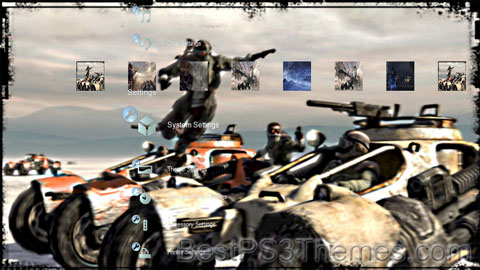
(1 background)
[[link]]s). However, do not replace these redirected links with a simpler link unless the page is updated for another reason (see WP:NOTBROKEN).Dead Space
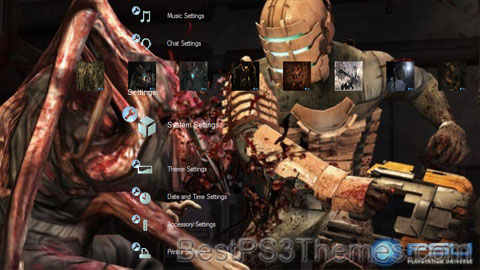
(1 background)
Dead Space 
Created by Glen Schofield Original work Dead Space Owner Electronic Arts Years 2008–present Print publications Novel(s) Dead Space: Martyr (2010)
see § Print mediaComics Dead Space Films and television Direct-to-video Dead Space: Downfall (2008)
Dead Space: Aftermath (2011)Games Video game(s) see § Main series Audio Soundtrack(s) see Music of the Dead Space series Official website ea Media[edit]
Year
Title
Developer
Platforms
2008
Dead Space[a]
EA Redwood Shores
Xbox 360,[1] PlayStation 3,[2] Microsoft Windows[3]
2009
Dead Space: Extraction[b]
Visceral Games
Wii, PlayStation 3
2010
Dead Space Ignition[c]
Xbox 360,[4] PlayStation 3[4]
2011
Dead Space 2[d]
Microsoft Windows, PlayStation 3, Xbox 360
Dead Space[e]
IronMonkey Studios
iOS,[5] Android,[6] BlackBerry PlayBook, BlackBerry 10
2013
Dead Space 3
Visceral Games
Microsoft Windows, PlayStation 3, Xbox 360
2023
Dead Space[f]
Motive Studio
Microsoft Windows, PlayStation 5, Xbox Series X/S
Main series[edit]
2008 Dead Space 2009 Dead Space: Extraction 2010 Dead Space Ignition 2011 Dead Space 2 Dead Space (mobile) 2012 2013 Dead Space 3 2014 2015 2016 2017 2018 2019 2020 2021 2022 2023 Dead Space (remake) Dead Space[edit]
Dead Space 2[edit]
Dead Space 3[edit]
Dead Space remake[edit]
Spin-offs[edit]
Dead Space: Extraction[edit]
Dead Space Ignition[edit]
Dead Space (mobile game)[edit]
Setting[edit]
Gameplay[edit]
Development[edit]

Music[edit]
Major characters[edit]
Isaac Clarke[edit]
Nicole Brennan[edit]
Nolan Stross[edit]
Ellie Langford[edit]
John Carver[edit]
Adaptations[edit]
Print media[edit]
Comic books[edit]
Novels[edit]
Film[edit]
Dead Space: Downfall[edit]
Dead Space: Aftermath[edit]